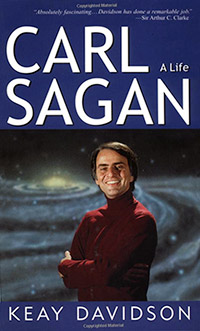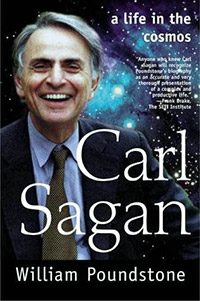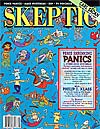During the final quarter of the 20th century, Carl Sagan (1934–1996) was the world’s most prominent scientist. He well deserves the two long, narrative biographies that have just appeared by well-known science writers William Poundstone and Keay Davidson. These books are written on a Scientific American technical level and include serious discussions of both scientific and social issues that were important to Sagan. Both are of interest to the skeptic community because of Sagan’s contributions to public science education and his interest in controversial claims.
Sagan’s Life and Personality
Sagan was propelled in his academic and public life by a wealth of talent and an intense drive to succeed. His lifelong quest was to understand the universe, especially our planetary system, and to communicate the thrill of scientific discovery to others. His life spanned exactly the “unique generation” (as he put it) of those privileged to see the planets transformed from tiny lights in the night sky into real worlds, each with its own geology and history. His enthusiasm for the process of scientific discovery is captured in the following quote, written in the early 1970s:
Even today, there are moments when what I do seems to me like an improbable, if unusually pleasant dream: to be involved in the exploration of Venus, Mars, Jupiter, and Saturn; to try to duplicate the steps that led to the origin of life on an Earth very different from the one we know, to land instruments on Mars to search there for life; and perhaps to be engaged in a serious effort to communicate with other intelligent beings, if such there be, out there in the dark of the night sky.
Between them, the two biographies provide a comprehensive picture of one of the most interesting scientists of our time, perhaps the only one to achieve true media celebrity. The man who emerges from these biographies is a compelling and complex personality, with immense talents and the ability to focus these talents on his career goals. Yet Sagan was also very human, and Davidson in particular threads his way through the other, less public aspects of Sagan’s lifelong search for truth — truth about himself as well as the cosmos. Poundstone’s book will probably appeal more to scientists, while Davidson, with his more speculative treatment of Sagan’s motivations and interpersonal relationships, is likely destined for a broader audience.
Sagan first gained public attention at age 40 with his appearances on The Tonight Show and the award of the Pulitzer Prize for his book Dragons of Eden. His name-recognition grew to worldwide fame (and wealth) as a result of his television series Cosmos and the book of the same title (with a remarkable 70 weeks on the New York Times bestseller list). During the 1980s he used this public recognition to promote three major causes: prevention of nuclear war, encouragement of a US-USSR partnership for human exploration of Mars, and public education on the nature and value of science. His work for peace centered on the concept of nuclear winter — a global climate disaster following a nuclear exchange that would leave no winners. Concern about nuclear winter clearly had an effect on both US and Soviet thinking, although it is too early to tell how significant these issues were in the eventual end of the Cold War. A joint Russian-American Mars mission seemed promising for a time, but ultimately was overwhelmed by the collapse of the USSR. Ironically, the end of the Cold War (which Sagan so strongly sought) had the corollary of discouraging the international exploration of space. Instead of beating swords (military missiles) into plowshares (scientific spacecraft), swords were destroyed or put into mothballs, with no space initiative to rise from the ashes. But let us examine Sagan’s role as skeptic, educator, and defender of science.
An Unorthodox Skeptic
Neither Poundstone nor Davidson probe deeply into Sagan’s role in the skeptical movement. I was surprised to find in both biographies only a couple of pages devoted to his wonderful 1995 book The Demon-Haunted World (DHW), or to his many articles in Parade magazine that reached an audience of tens of millions. Fortunately, however, these two biographies receive a timely supplement in Joel Achenbach’s delightful new book Captured by Aliens (reviewed on p 94). Journalist Achenbach examines the science and pseudoscience of ETs and recognizes Sagan’s unique position as the most outspoken defender of the legitimacy of exobiology and SETI as scientific disciplines. Sagan was the “keeper of the gates” who effectively defined the border between science and pseudoscience. As such, he was actively courted (and subsequently hated when he rejected them) by many fringe figures who sought in his blessing a legitimization of their interests or beliefs.
Sagan himself held opinions that some conservative colleagues considered very close to the fringe, especially his lifelong interest and advocacy for exobiology and the search for extraterrestrial life. Sagan tried to keep an open mind, to entertain possibilities that others might find outlandish. Davidson notes that Sagan sometimes felt that professional skeptics were too dogmatic, too inclined to speak from authority — and that this attitude was tactically unwise. Sagan expressed these concerns in DHW as follows:
The chief difficulty I see in the skeptical movement is in its polarizations: Us vs. Them — the sense that we [skeptics] have a monopoly on the truth; that those other people who believe in all these stupid doctrines are morons; that if you’re sensible, you’ll listen to us; and if not, you’re beyond redemption. This is unconstructive. It does not get the message across.
The message that science and rational thinking are preferable to self-delusion and flimflam was central to Sagan’s philosophy. He argued that every citizen in a free society needs a “baloney detection kit” to help sort out truth (that is, rational, scientific truth) from fantasy and delusion. The following are typical comments from DHW:
It is far better to grasp the Universe as it really is than to persist in delusion, however satisfying and reassuring…. Superstition and pseudoscience keep getting in the way, providing easy answers, dodging skeptical scrutiny, casually pressing our awe buttons and cheapening the experience, making us routine and comfortable practitioners as well as victims of credulity. The tenants of skepticism do not require an advanced degree to master, as most successful used car buyers demonstrate.
Davidson explains why Sagan was so threatening to believers:
Sagan believed he had to do more than champion science; he had to attack its antithesis, pseudoscience. He was an especially effective opponent of pseudoscience because he was not an “establishment” figure. Sagan was too young, light-hearted, and prolific a speculator to be dismissed by pseudoscientists as just another academic party pooper. Hence, in the mid-1970s as his writing and television career took off he came to be perceived as the most effective critic of the pseudoscientific wave in pop culture.
Let’s look briefly at three examples of this confrontation.
UFOs and Alien Abductions
Sagan’s first widely read book, Cosmic Connection, was published in 1973. In it he devoted several chapters to the possibility of extraterrestrial life, with emphasis on the prospects for detection of extraterrestrial radio signals (SETI). He also criticized those who promote tales of UFOs, especially the then-popular books on “ancient astronauts” by Eric von Daniken. But this was not the beginning of Sagan’s interest in UFOs. As a student, he had advocated the study of UFOs as possible extraterrestrial vehicles, only reluctantly abandoning this position when he realized how internally inconsistent the various “sighting” were, and how unreliable the accounts of witnesses. But he never entirely gave up. He toyed with the idea suggested by his Russian colleague I.S. Shklovskii that Phobos, the larger moon of Mars, might be a huge artifact of some earlier Martian civilization. Mariner 9’s up close photographs, however, revealed a rocky satellite of natural origin.
Toward the end of his life, Sagan devoted several chapters in DHW to the subtler issues of self-delusion, hallucination, and the convincing memories of false events that can be induced by hypnotism and the suggestions (sometimes inadvertent) of interviewers and therapists. Sagan takes this seriously — he does not reject evidence out of hand. In the end, however, he asks:
Is there a “signal” hiding in all that noise? In my view, there are no cases — despite well over a million UFO reports since 1947 — in which something is so strange that it could only be an extraterrestrial spacecraft is reported so reliably that misapprehension, hoax or hallucination can be reliably excluded. There’s still a part of me that says “Too bad.”
Velikovsky
During the 1960s, the pseudo-cosmologist Immanuel Velikovsky developed a substantial following, with “scientific conferences” and “technical journals” devoted to examining his peculiar ideas about planets spinning from their orbits and careering through the solar system within historic times. There were also a number of scholars and journalists who felt that Velikovsky had been badly served by attempts made by Harlow Shapley and other influential scientists to discourage the publication of his sensationalist 1950 book Worlds in Collision. Velikovsky and his followers taunted the scientific establishment for its unwillingness to give his ideas a fair hearing.
Against this backdrop, Sagan organized a public debate at the 1974 annual meeting of the AAAS, with Velikovsky invited to present and defend his views. As Davidson writes: “The debate would constitute, in effect, an apology to Velikovsky [for previous slights from astronomers], giving him the opportunity to submit his ideas to direct scientific scrutiny. The debate’s ultimate goal was not to reassess Velikovsky’s ideas (hardly any scientist took these seriously), but, rather, to reassure the public of science’s basic fair mindedness.”
The high drama of the event centered on the confrontation of the octogenarian patriarch Velikovsky and his young, brash critic, Sagan. It was a clash of immense egos on both sides. Sagan aimed his remarks primarily at the public and science journalists, and by most accounts he was hands-down winner (Sagan’s presentation appears in Scientists Confront Velikovsky edited by symposium co-organizer Donald Goldsmith. Unfortunately Velikovsky did not allow his paper to be published). Many people credit this debate as the beginning of the end for the Velikovsky cult, which is today reduced to a handful of marginalized true believers.
Sagan’s critique of Worlds in Collision is brilliant popular science writing, not really a serious technical discussion of Velikovsky’s ideas (most of which hardly deserve such scrutiny). A few of Sagan’s arguments, especially concerning the probabilities of planetary collisions, are a bit too glib and rhetorical. This infuriated the Velikovsky supporters, who perceived that Sagan not only was attacking their hero, but that he also did not take them seriously enough to engage in what they would consider a true scientific debate. They still damn Sagan for the “scientific inaccuracies” in his presentation. Ironically, while many scientists criticized Sagan for debating an obvious crank, Velikovsky fans castigated him for not engaging their hero more seriously.
Some academic critics from outside the physical sciences still question how Sagan and other astronomers could reject Velikovsky without reading his books and carefully studying his ideas. Perhaps they don’t understand how readily someone with sound technical training and physical intuition can recognize such pseudoscience. You don’t have to consume an entire meal of spoiled food to recognize the problem — one or two bites is enough.
The Face on Mars
In 1976, the Viking spacecraft in orbit around Mars photographed a strange-shaped mesa about a mile across that looked (in this low-resolution view under oblique lighting) remarkably like a human face. Unfortunately, the Viking mission did not obtain other better views, and there ensued a two-decade hiatus in successful Mars missions. This presented an opportunity for a cult to develop centered on the idea that this really was a human face, carved by intelligent Martians, perhaps part of a scheme to communicate with Earth. With the passage of time, the story grew even more convoluted, complete with ruined pyramids and cities, and with geographic relationships on Mars and yielded, to a chosen few, the mathematical foundation of an extraterrestrial technology.
Year after year, Sagan was asked by journalists and the public about the reality of the “Face.” Most scientists scoffed at such questions, but Sagan took them more seriously — not the nonsense about the pyramids and cities and secrets of unlimited energy, but about a possible artificial origin for this enigmatic geological feature. Like many scientists, Sagan believed that Mars could have once supported life, and he could not logically exclude the remote possibility of some surviving surface features that could point to the time when Mars was a living world. Sagan wrote in DHW:
I might be wrong [about the Face on Mars]. It is hard to be sure about a world we’ve seen so little of in extreme close-up. These features merit closer attention with higher resolution. Even if these claims are extremely improbable — as I think they are — they are worth examining. Unlike the UFO phenomenon, we have here the opportunity for a definitive experiment. This kind of hypothesis is falseifiable, a [property] that brings it well into the scientific arena.
Achenbach tells a story of Sagan’s role as “gatekeeper” of scientific legitimacy, based on an interview with Richard Hoagland, leader of the Face on Mars cult. Hoagland explained that in a public meeting in 1985, Sagan stated that those planning NASA missions to Mars should be open to unexpected discoveries. This is the sort of comment Sagan made often, advising his colleagues to be receptive to new ideas. But according to Hoagland, when Sagan made these remarks, he briefly made direct eye contact with Hoagland among the journalists in the audience. Sagan’s innocent comment thus became a coded message encouraging Hoagland to pursue his advocacy of an artificial origin for the Face. Hoagland argued to Achenbach that this “endorsement” legitimized his continuing crusade, even after the Mars Global Surveyor obtained high-resolution photos that dispelled any possibility of an artificial origin.
I have sometimes wondered if Sagan really entertained the possibility — even the extremely unlikely possibility — that the Face had an artificial origin. Or did he use this example for its educational value — as an easily understood example of a hypothesis that could (and would) be tested by new data? Or could he have been willing to keep the issue alive as a motivation for further exploration of Mars? Or was he just being scrupulously honest and rational? Perhaps all of the above.
Conclusion
Carl Sagan was one of the intellectual giants of our time — not for his scientific discoveries or his technical articles, but for the example and inspiration he provided to tens of millions who read his articles or saw him on TV. He was, in effect, humanity’s main guide and interpreter during the decades that we first explored our solar system. We are fortunate that he not only interpreted science well, and in terms everyone could understand — he also undertook the more challenging task of explaining how science works. He was the most prominent advocate of scientific skepticism, carrying a message that too few people want to hear. These biographies are entertaining but serious works about a remarkable man. They do not focus on Sagan as skeptic, but his defense of rational thought, and his willingness to entertain diverse ideas and test them against the rigors of logical analysis, were central to Sagan’s character and thus should infuse any book about his fascinating and influential life.
This article can be found in
volume 07 number 4
Pseudoscience
this issue includes: When Satan Came to Texas; the Madness of Crowds; Million Dollar Madness; ET May Be Out There; Anatomy of Nonsense; Cloning Forum; Special Carl Sagan section…
BROWSE this issue >
ORDER this issue >
This article was published on October 29, 2009.

















